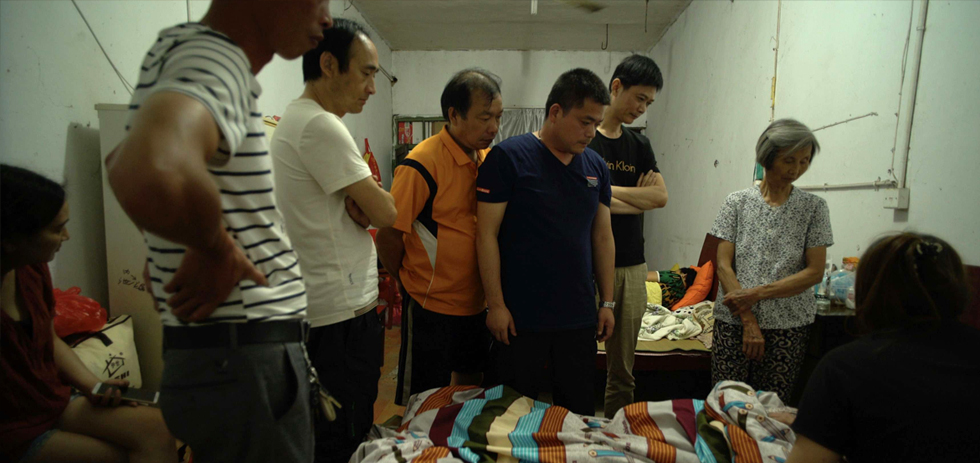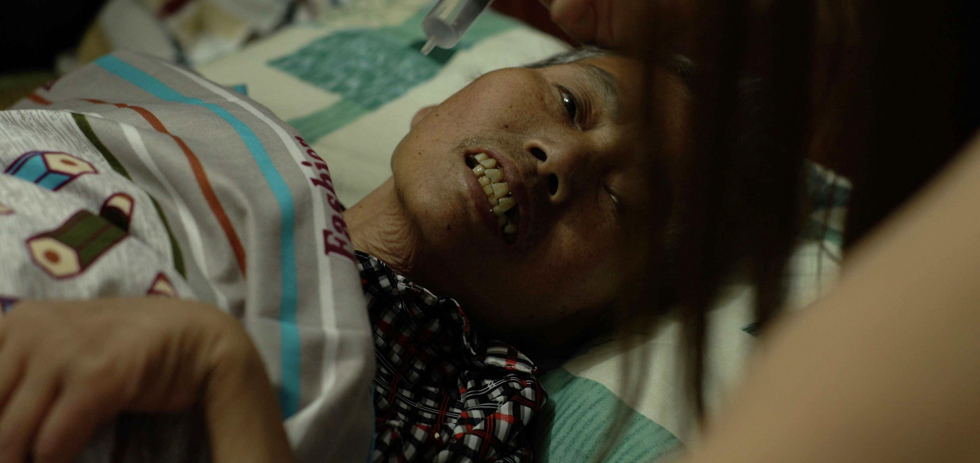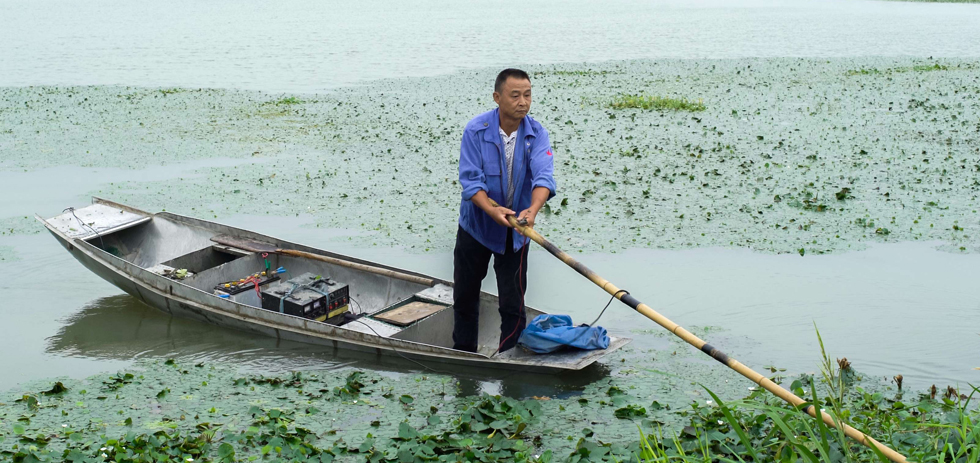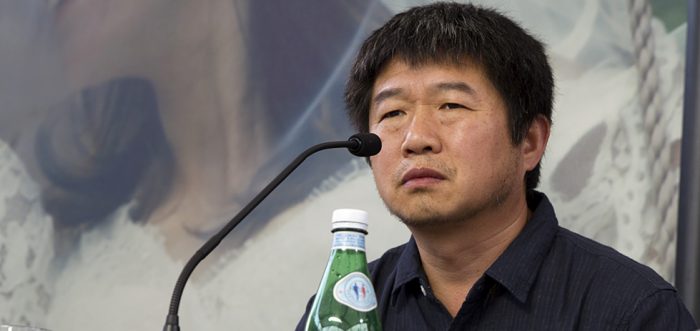With a remarkably steady output of films over the last fifteen years, Wang Bing has become one of documentary cinema’s most revered filmmakers.1 He’s never been short of ambition, either; Wang begun his career with the nine-hour documentary Tie Xi Qu: West of the Tracks. His work has captured exclusion, conflict, and neglect on film, addressing them specifically as symptoms of inequality. His new film Mrs. Fang is his second shortest feature – 2009’s 53-minute Coal Money is the shortest – of his career.2 Though fans of Wang’s longer films should not despair; the director released a second film in 2017: 15 hours. As it’s title suggests, the single-shot documentary, set in a garment processing facility in China is, very much, 15 hours long.3
Despite its brevity, Mrs. Fang is one of Wang’s most tightly-focused works. Set in Zhejiang in Eastern China, the film is focused on the final days in the life of the titular Fang Xiu Ying, who is dying from Alzheimers.The work plays as an aching character study, underpinned by a practiced, filmic intuition. His invaluable sense for intimacy offers a series of invaluable portraits: the end of a life, the process of accepting death, and the pervasive inequality and societal neglect that created the conditions for an acceleration of corporeal decay in the first place. It’s a film underpinned by a profound sense of discomfort: we watch a subject at their most vulnerable and defenceless. Mrs. Fang offers austere and lingering insights, but the challenging work they emerge from is built on ethically questionable turf, a context certain to divide even die-hard fans of the director.
We spoke to Wang Bing about Mrs. Fang at Locarno Film Festival – shortly before the film premiered at the festival, where it went on to take out the top prize, the Golden Leopard.
I went into Mrs. Fang having seen the majority of your work, and it cuts an immediate and obvious contrast to a lot of your earlier works when it comes to duration. I’ve watched Tie Xi Qu: West of the Tracks on two occasions. It’s a stunning and consuming piece, and the 9-hour duration contributes a huge amount to that experience. Even with recent works like Ta’ang, Bitter Money and ‘Til Madness Do Us Part, they’re all relatively lengthy works. When it comes to your latest film Mrs. Fang, however, it starts and ends with an unfamiliar brevity – not to say that as a negative, but more to point out that I found that conciseness as something that distinguished it from many of your more ambitious outings. Did you have a particular preconception when it came to how long you wanted the work to be?
I started editing of the film, most of it – 60 minutes, 70 minutes – when I was in Beijing. When I moved to Paris for work, I started to finish the last 15 minutes in the second session of the editing. It’s not like I decided in advance how long the film would be. It is very much related to the footage. As you know in this footage, there is not much talking from the main characters… exactly. So, it’s very much the feeling about the editing being finished as soon as I’ve told the story. It doesn’t depend on me deciding how ‘long’ the film is going to be, or ‘has’ to be. It’s very much based and related to the footage that I collect.

One of the most recurring pieces of footage throughout Mrs. Fang is the close-up of her face, lingering on the nuances of her expressions – or lack thereof. The unobtrusive approach you’ve taken to documentary has always been a major part of your work. I’m still interested in the process that underpinned Mrs. Fang: as a deeply intimate film, with this recurring image of vulnerability taking such a central place in the work.
When I started to shoot Mrs. Fang, she was very sick. She was lying in bed and she was not talking. So what I did on the very first day, was to do this shooting for about two hours. Most of this shooting was the close-ups. I wanted to learn about this Mrs. Fang in the condition she was in at the time. After those two hours of shooting, I went back to my place and I watched the footage again and again. I was trying to figure out how I could create a story; what this footage could tell me about Mrs. Fang. When I started to watch the footage, I focused very much on her eyes. I found out that those eyes had a kind of light that told me she was still alive. She was already sick and was unable to speak. I was trying to understand how I was going to keep shooting her. I was thinking the best option would be to shoot the truth through her eyes. Her story. This is why there were so many close-ups.

With her being unable to communicate, how did you approach that sort of a subject? Did you initially get involved through talking to her family, I think it said in the end credits? I wanted to know more about that: how that story developed, with you being brought in and developing a relationship with the family and a subject that is so vulnerable – and how you dealt with that?
I already knew the family because I met Mrs. Fang’s daughter sometime before, in 2015. In that period of time I was shooting another documentary – another story – not far from the village where Mrs. Fang lived. When I met the daughter, I was invited to go and visit the family, and see the house. At that time, Mrs. Fang was in good health.
That was the footage at the start of the film, the early footage?
Yes, that was the early footage. At that time, we were just talking, a little bit of talking. Since I was interested in Mrs. Fang, I had this idea, talking to the daughter, saying, ‘I would be interested in making a documentary about your mother.’ But at that time it was just an idea. So I left, because I had other work to do. After one year had passed – in 2016 – I received a phone call from the family of Mrs. Fang, from the daughter, saying, “You know, my mama is getting sick. What do you want to do, do you want to come back?” I decided to go back, but at that time Mrs. Fang was very ill. She was already lying in bed. I had about seven days before she died.

The idea was: we already knew each other, I already knew the family previously, I’d already met Mrs. Fang in another situation. In that year, the idea I had in mind – to make a documentary about Mrs. Fang – never happened, because it was very busy. The time passed by and then I received this phone call from the family and decided to go anyway. There was around seven days of shooting before Mrs. Fang died. Around the fifth day… I mean somebody was dying, it’s not that easy. Being there, shooting. The family accepted the idea because we knew each other already. The neighbour, though, was not that easy. They felt a little bit of pain, so after the fifth day of shooting, I decided to stop for one day. I decided we were not to shoot anything, to let people go back to that environment of sorrows. It’s painful. On the sixth day, I started to shoot again – until the end.
Right. I know you’ve got to run off to introduce the film now, so this is all we’ve got time for. Thanks again for the interview. Hopefully we can have a longer one in the future. Good luck in the competition!
Thank you for the chat.
